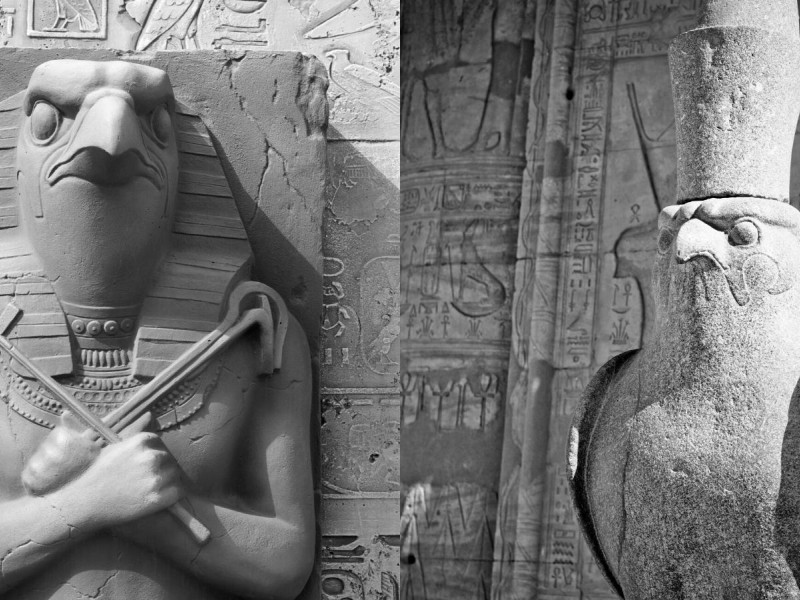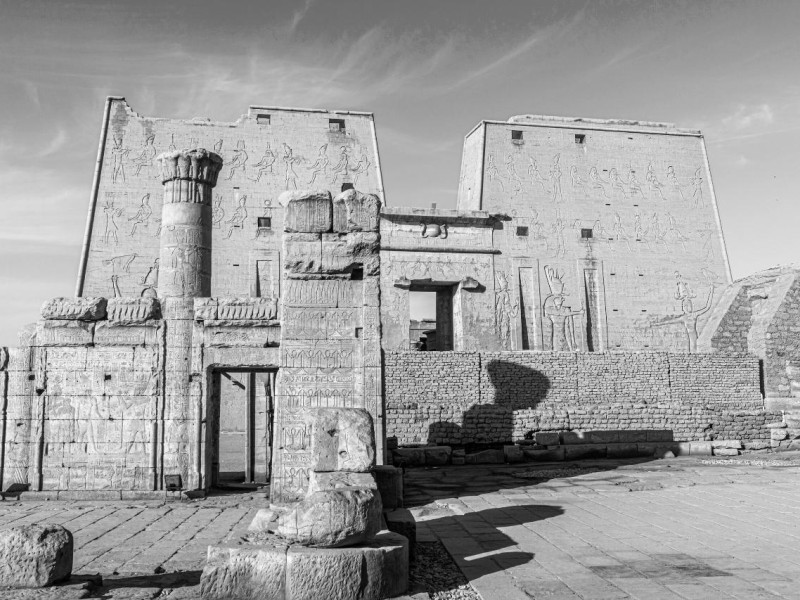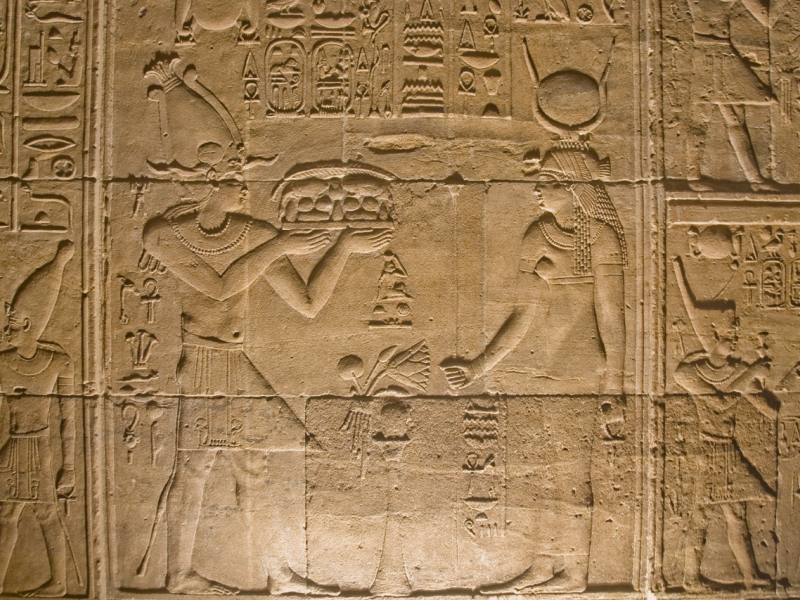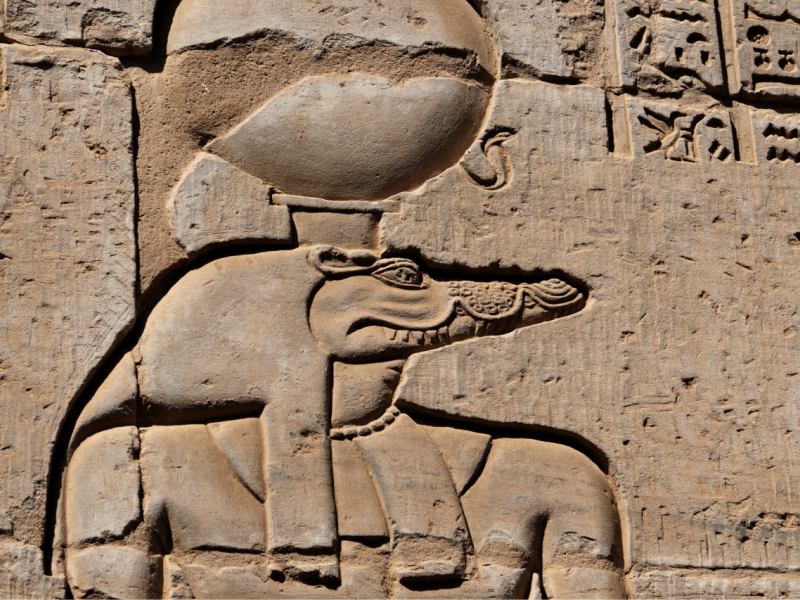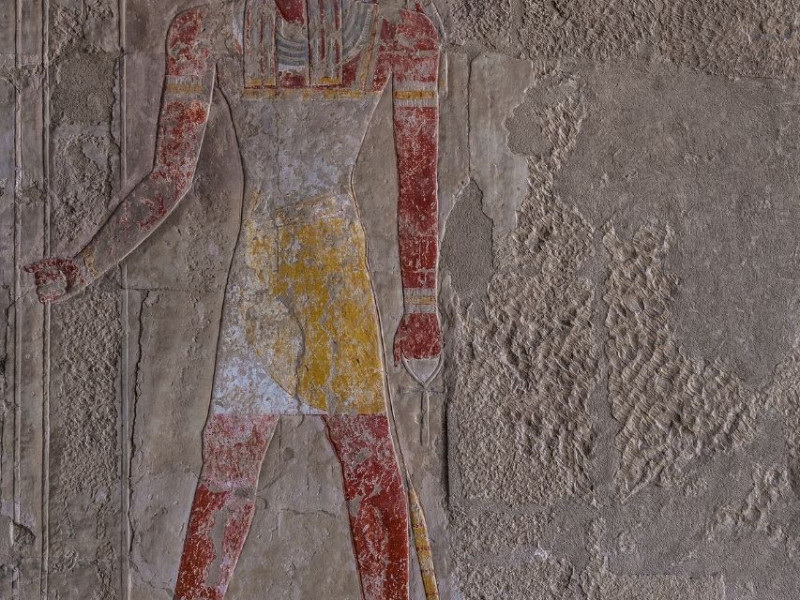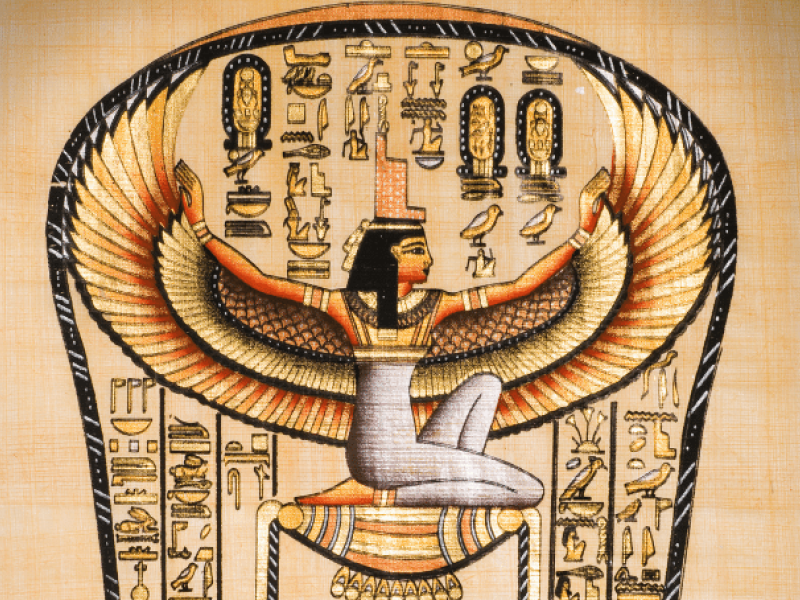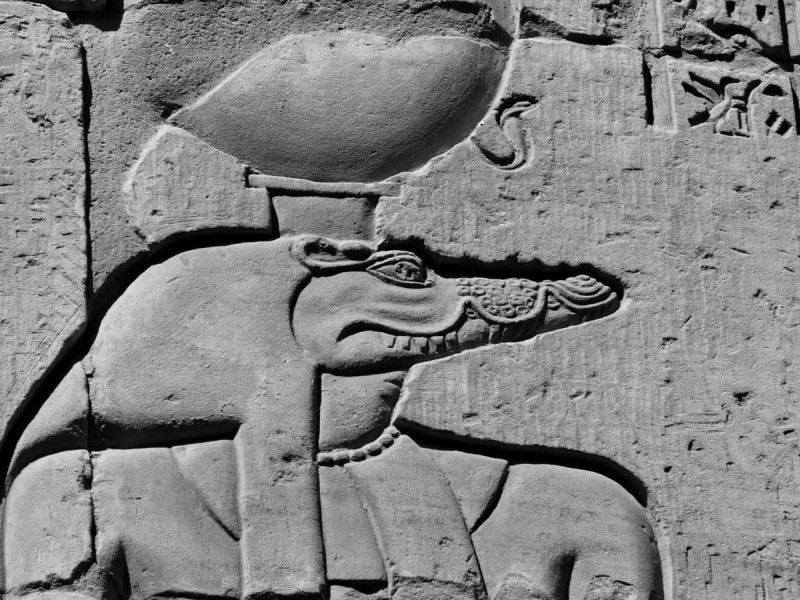Horus
Horus: The Falcon-Headed God of the Sky and Deity of Divine Royalty
In this in-depth bio, you will learn who Horus was, his history, and the myths and beliefs surrounding his name.
You will also learn:
Who was Horus in Egyptian mythology
Depictions of Horus in Egyptian artwork and literature
The power of the Eye of Horus
The meaning of Horus’ names and titles
Horus the Elder, the first national god of Egypt
The myth of Horus and Osiris
The birth of Horus
Horus’ vengeance upon Set
Horus and divine kingship
Who Was Horus in Egyptian Mythology?
Horus was the ancient Egyptian deity of divine royalty, pharaonic rulership, and the god of the sky who served numerous functions and roles throughout Egyptian society. Worshipped in various forms from Predynastic Egypt (circa 6000 BC) until the rise of Roman Christianity in the 3rd century AD, Horus’ depictions throughout Egypt’s history were so varied that Egyptologists treat the forms of Horus as separate and distinct gods.
The most famous forms of Horus are Horus the Elder, Horus the Younger, Horus of Behdet, Horus of the Horizon, Horus of the Two Eyes, and Golden Horus Osiris.
The most popular myths of Horus named him as the son of the slain Osiris (god of the dead and resurrection), who assisted his mother Isis (goddess of motherhood, magic, healing, and renewed life) in resurrecting his father, and thus becoming the chief rival of his father’s murderer, Set (god of violence and disorder).
Horus and Anubis (lord of the dead) were believed to be brothers, and Bast (goddess of cats and protection) was his sister. Horus was also worshipped as both the husband and father of Hathor (goddess of the sky, fertility, and passion).
Depictions of Horus in Egyptian Artwork and Literature
The most common depictions of Horus illustrate the deity as a human with a falcon’s head, often depicted with a Uraeus (a cobra-headed crown that signified divine rule and the power of light) or the Pschent (a double-headed crown symbolizing the unification of Lower and Upper Egypt).
As Horus was the god of the sky, he was also representative of the sun and moon as they were considered within the sky’s provenance. So in this aspect, the sun was considered Horus’ right eye and the moon his left, with each being pulled across the sky by the falcon god (drawing comparisons between Horus and Ra).
In artwork depicting him in his younger form, Horus was represented as a suckling boy with a curled lock of hair sitting upon the lap of his mother, Isis. Other depictions show Horus as a naked youth with a finger in his mouth sitting upon a lotus flower.
Numerous depictions of Isis and Horus are believed to be precursors to depictions of the Virgin Mary and the baby Jesus. However, a great deal of scholarly controversy exists comparing the deities. Some dubious authors have gone so far as to suggest that the story of Jesus’ crucifixion came from an earlier story of Horus’ crucifixion.
However, no legitimate myth of Horus’ crucifixion has been found in the records of Egypt, as crucifixion was a Roman method of execution that was considered abhorrent in Egypt. Also, no records of crucifixion existed in Egypt until after 30 BC, whereas most of the myths of Horus were commonplace 2,000 years prior.
Horus’ hieroglyph was a falcon, as the falcon was considered representative of the sky. Due to the popularity of Horus throughout the Egyptian empire, falcon cults were widespread and commonplace.
The Power of the Eye of Horus
One of the most famous symbols of ancient Egypt is attributed to the falcon god – the Eye of Horus. The Eye of Horus was believed to protect the pharaoh in the earthly realm and the afterlife. The powerful symbol (either a stylized falcon eye or a pair of eyes) was also believed to ward away evil from all who wore it.
It was a favorite of Egyptian sailors who would paint the Eye of Horus upon their fishing and sailing vessels to protect them from the risks of the sea. The Eye of Horus also symbolized healing, restoration, and wholeness.
Believed to be conferred upon humanity by the gods, the Eye of Horus was a potent symbol found on many depictions of Isis and other deities. The Eye of Horus, called the wedjet by the ancient Egyptians, was originally associated with the goddess Wadjet, a solar deity. The symbol represented her all-seeing eye upon the sky.
As the cult and stories of Horus grew, the wedjet came to be associated with the falcon-headed god. Central to the story of Horus was his battle with Set in avenging the murder of his father, Osiris. While Horus was a brave and valiant warrior, Set was the god of violence known to use brutal tactics and whatever was at his disposal to win.
While fighting, Horus took one of Set’s testicles during battle, but in turn, the god of violence viciously gouged an eye from Horus’ face. Hathor, the consort of Horus, restored Horus’ eye by using the wedjet, healing his sight and granting him even greater magical abilities. In this way, the Eye of Horus symbolized healing and the concept of gain through sacrifice.
Some iterations of the Horus’ myth state that Set gouged out both of his eyes. Thoth then came to Horus’ aid by healing his eyes with the wedjet. Upon being healed, Horus offered the wedjet to aid in the resurrection of Osiris, which helped raise the god in the afterlife. Because of this, Osiris adapted the symbol for use in the Duat (underworld).
While popular in the realm of the living, funerary artwork and amulets featuring the Eye of Horus were even more common in the realm of the dead. This is because the Eye of Horus was believed to enable the deceased to see easier in the afterlife and ward off attacks from evil entities when passing through the underworld.
The Meaning of Horus’ Names and Titles
Horus (also known as Her, Hor, Heru, and Har) translates simply as the ancient Egyptian word for “falcon” (hr.w, reconstructed as ha-ruw). Other possible meanings of Horus’ name are the “one who is above,” “the one who is over,” “the high one,” or “the distant one.” Other translations name Horus as Siese (Son of Isis), Harsiese (Horus Son of Isis), and Horos.
As the earliest form of Horus (Horus the Elder), Horus’ name was titled Herwer and Haroeris. This aspect of Horus was believed to be the son of the twins Geb (god the earth) and Nut (goddess of the sky) but was, in truth, an amalgamation of dozens of territorial gods.
Egyptologists believe that Horus the Elder was the first nationally recognized god of Egypt, leading Horus to become the patron god of the Egyptian kings. Horus the Elder’s official title was “God of the Kingdom.”
When in the form of Horus the Younger, Horus’ name was sometimes mentioned as Nephorus or Nophoros, meaning “Good Horus.” His official name was Heru-pa-khered.
Other essential names and titles of Horus were:
Heru-Behdeti – Horus of Behdet, representing the winged sun that flew across the sky
Horemakhet – Horus on the Horizon, representing the early morning sun being birthed upon the horizon. In this depiction, Horus was believed to appear as a hieracosphinx, a mythical creature with a falcon’s head and a lion’s body with wings. Several scholars believe the hieracosphinx was the original inspiration behind the Great Sphinx of Giza
Hersematawy – Horus Uniter of the Two Lands, representing a unified Egypt and depicted with the Egyptian Pschent (double crown)
Hor-Merti – Horus of the Two Eyes, usually marked with the double wedjet
Iunmutef – Horus, Pillar of His Mother, depicted as a human priest wearing leopard skin. This was the most common depiction of Horus found in the tomb of Nefertiti
Herui – The Double Falcon of the Horuses
Horus the Elder, the First National God of Egypt
Believed to be one of the oldest gods of ancient Egypt, the first myths of Horus named him as the son of the god of the earth, Geb, and the goddess of the sky, Nut. In these earlier iterations of Horus’ myth, Horus was the younger brother of Osiris and Isis, with Horus given charge of the sun in the sky. Other versions of Horus’ the Elders myth name him as the son of Hathor, while yet other versions name Hathor as his wife, his mother, and daughter.
In his role as a falcon god, Horus the Elder’s eyes were believed to be the moon and the sun that watched over his people. Referred to as The Distant One, Horus (and his consort Hathor) were believed to fly from Ra himself to bring the god news of the world or to assist people who needed help.
Egyptologists now believe that there were many falcon gods worshipped regionally throughout Predynastic Egypt (6000 – 3050 BC) that eventually merged into the worship of one god – Horus. As one territory defeated another or merged with others over time, these territories merged their myths as well.
The kings of Predynastic Egypt titled themselves Followers of Horus, indicating that even before the established Egyptian empire was formed, Horus held an essential role in the governing of the kingdom.
By the Early Dynastic period, Horus was already well established and linked with the rulership of Egypt. Egyptologist Margaret Brunson wrote The Serekh, the earliest of the king’s symbols, depicted a falcon on a perch. “As a result, devotion to Horus spread throughout Egypt but in various locales the forms, traditions, and rituals honoring the god varied greatly.”
Due to these many and varied interpretations of Horus’ myth, eventually, the beliefs of Horus the Elder gave way to Egyptian pharaohs more closely identifying with the more dynamic myths of Horus the Younger.
The Myth of Horus and Osiris
The most well-known story of Horus comes from the Osirian Resurrection Myth, which became one of the most dominant beliefs of ancient Egypt. In this myth, after the world was created, Osiris and Isis designed their paradise within it.
The first human beings created from the tears of Atum were brutal and barbaric, not understanding the greatness that lay within them. Osiris wished to teach humanity the ways of the gods to civilize and protect them.
Osiris taught mankind how to honor the gods, religious holidays, cultivate seed and plant life, and the power of art and literature. Isis gave humanity gifts of food and blessings. Osiris and Isis had created the perfect paradise for Atum’s creation, and no one lacked anything. It was a time of perfect peace and fulfillment.
Set, the god of chaos and destruction, was not so satisfied. As the brother of Osiris, he was jealous of the attention and honor that was bestowed upon Osiris and his wife, and he desired the same. His jealousy turned to vicious hatred when Set discovered that his wife, Nephthys, desired Osiris and had deceived Osiris into sleeping with her, as she had transformed herself into the image of Isis to seduce him.
Filled with rage, Set designed a plan to kill his brother and usurp his power. Set created a box to Osiris’ specifications and asked his brother to lay inside. Upon laying in the box, Set quickly closed the lid and hammered nails into it, trapping Osiris inside and creating the first coffin. Throwing the coffin into the Nile and leaving Osiris for dead, Set took control of the land and began a brutal reign with the goddess Nephthys.
The coffin drifted down the Nile until it became stuck in a tamarisk tree near Byblos, and over many years became enfolded within it. One day, a local king discovered the tree and desired its unique beauty, so he had it removed to become a pillar in his court. While this was happening, famine and destruction had fallen upon the paradise that Osiris and Isis had created, as Set ruled with an iron fist and ignored the needs of the humans in his care.
Knowing that only Osiris could help the people he loved, Isis began to search the Nile for her husband. After hearing of a unique tree pulled from the Nile and resided in the court of the King of Byblos, Isis traveled to the kingdom, asked the king for its return, and discovered the dead body of Osiris within.
The Genesis of Horus
Believing that she could bring Osiris back to life, Isis asked Nephthys to keep Osiris hidden while she collected the necessary ingredients to revive the dead god. However, Set had learned that his brother’s corpse had been discovered and tricked Nephthys into revealing its hiding place. Still filled with rage, Set hacked the body of his brother into pieces and tossed the bits across Egypt and into the Nile river.
Upon returning, Isis was distraught over Set’s vile act, and Nephthys informed her how Set had deceived her into revealing Osiris’ body. After searching all of Egypt, Isis and Nepthys discovered the missing body parts of Osiris and reassembled the god, then realizing that one piece of Osiris was missing – his penis. Searching high and low, the goddesses discovered that a fish had consumed Osiris’ penis and that the god would never be whole.
Still believing she could return the god to life, Isis, with the help of Nephthys, revived Osiris, but as he was incomplete, he could no longer reign in the land of the living. Osiris would have to descend to the Duat and reign as the god of the dead.
Before leaving the world of the living, Isis transformed herself into a bird and flew around and around Osiris’ body, pulling out his semen and into herself, thus becoming pregnant with Horus. As Osiris disappeared into the underworld, Isis fled, fearing for her life and that of her unborn child, and hid in the delta region of Egypt away from Set’s gaze.
The Vengeance of Horus
Giving birth to Horus all alone in the swamps of the Nile Delta, Isis hid herself and her son in the thrush and thickets of the water. Set had ordered his demons to hunt for the woman and child, forcing Isis to leave Horus in the care of the goddess Selket while she searched for food. Isis and Selket (goddess of scorpions and canopic jars) taught Horus about his family and responsibilities. Then, they raised him until he was old enough to challenge Set and restore the balance of Maat (righteousness).
The most well-known version of the battles of Horus and Set comes from the work The Contendings of Horus and Set, written down between 1090 – 1077 BC. In this version of the myth, Horus brought a formal complaint against Set before a tribunal of the gods. As the usurper of the kingdom, Set was seated on the tribunal, as was Osiris, now lord of the dead.
Horus claimed that Set had illegally taken the throne of the living from Osiris, and therefore was an illegitimate ruler. Horus asked the tribunal to decide who the kingdom’s true ruler should be between Horus and Set.
The majority of the gods immediately chose Horus, except for Ra, the supreme god, and deciding vote. Ra claimed that while Horus had a proper claim, he was much too young and motivated by vengeance, while Set had ruled for many years and was more experienced. Thus, it was declared that Horus and Set would have to compete in a battle to prove who was more fit to rule.
Over 80 years, Horus and Set battled, with Horus victorious every time. Horus even castrated Set, with Set also gouging out one of Horus’ eyes during these battles. Ra continually denied Horus’ claim, even though the god defeated his murderous uncle on each occasion.
Finally, unable to deal any longer with the destruction of the paradise she and her husband had created, Isis transformed herself into a beautiful maiden and placed herself crying upon the steps of Set’s palace. After returning from battle, Set saw the young maiden and asked why she was so distraught. Isis told Set a story of how a wicked being, her husband’s brother, killed her husband and seized his land and now sought her and her son’s destruction.
Incensed by her story, Set announced that the man should be punished and that he would not rest until he found the perpetrator and restored the woman and child to their proper place. Isis then revealed her identity to Set, and the god realized he had condemned himself. Ra then agreed with the gods that Horus had the right to be king. Set was banished to the desert, and Horus assumed the throne as the rightful king.
Horus’ Role in the Establishment of Divine Kingship
As the symbol of restored order, Horus was believed to be the direct link between the paradise of Osiris and Isis and humanity. Because of this, the kings of Egypt, beginning with the first dynasty until the Roman Occupation almost 3,000 years later (except for one king), chose a Horus name derivative to rule during their coronation.
As the earthly representative of Horus, the pharaoh reflected the divine right to rule the living realm. In death, since the pharaoh was believed to be a descendent from Horus, the king was also believed to be a descendant of Osiris.
Therefore, the pharaoh was also a king of the dead. Thus, the pharaoh by design was the king of both life and death, a living god who was mortal and eternal. Additionally, in life, the king was believed to be under the protection of Isis.
As the pharaoh was named the divine house and the representation of the balance of righteousness, every citizen of Egypt was believed to be under the protection of Horus. Therefore, Horus was worshipped and honored in nearly every Egyptian temple and was a constant presence in the lives of Egyptians for almost six thousand years.
Conclusion: Horus, God of the Sky and National Hero of Egypt
Horus was the ancient Egyptian deity of divine royalty, pharaonic rulership, and the god of the sky who served numerous functions and roles throughout Egyptian society. Worshipped for over 6,000 years, Horus was a foundational deity within the Egyptian pantheon.
Horus was initially worshipped as a god who pulled the moon and sun across the sky, a regional deity who was an amalgamation of falcon gods in the culture of early Egypt.
At the height of his worship, Horus was the defender of the kingdom of Egypt and the symbol of true divine authority.
Typically pictured as a falcon-headed human, Horus was depicted as both man and child. When depicted as a child, Horus was often pictured with his mother, Isis.
The Eye of Horus is one of the most well-known images from ancient Egyptian culture, a symbol of protection, restoration, healing, and wholeness.
As one of the primary gods of Egypt, Horus’ (Her, Heru, Hor, Har) name meant falcon.
Over time, Horus’ name came to mean the one who is above, the one who is over, the high one, and the distant one.
As Horus the Elder, Horus was known as the first national god of Egypt and a symbol of divine authority.
The myth of Horus and Osiris is one of the most well-known and enduring Egyptian myths, explaining the establishment of order over usurped chaos, the power of parental protection and maturity, and legitimate authority.
Horus was honored by (nearly) every pharaoh throughout Egypt’s history who took Horus’ name as their coronation name on becoming king. Horus was their link to divine authority in life and death, making the king a living god.
As the symbol of the divine right to rule, the god Horus held a hallowed place in the lives of Egypt. Horus was more than just a symbol of the king; he was a hero of a kingdom who was honored and revered not just over Egypt’s history but for the vast majority of written history.




